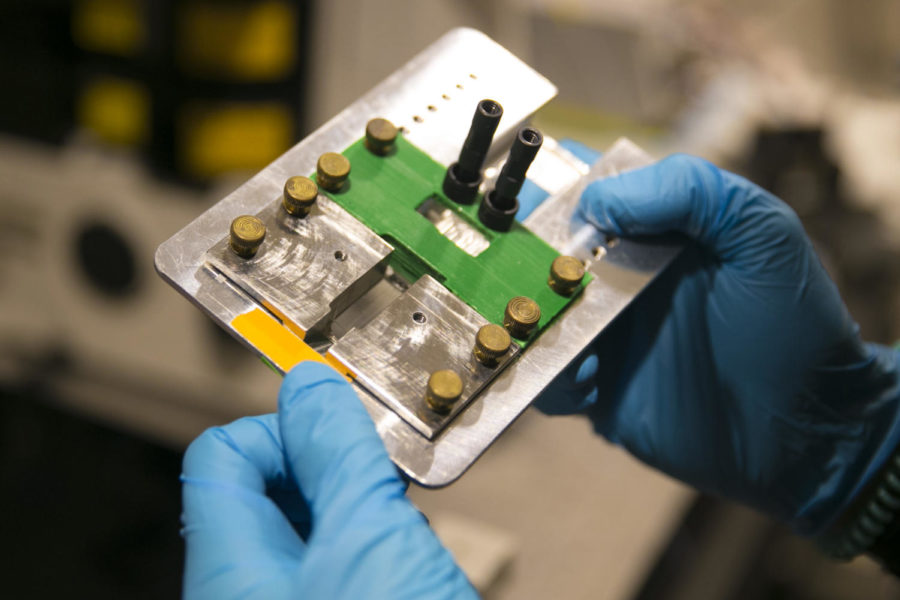Editing the Myths About Gene Editing
Gene editing should be embraced instead of feared.
PHOTO | TNS
Stephen Jones, a molecular biology postdoctoral, shows the CHAMP, a device created for scientists to more safely use a new kind of gene editing technique called CRISPR, in the laboratory of UT professor Ilya Finkelstein Aug. 11, 2017. Photo by MCT Campus.
Despite what some mainstream media may be telling its readers, the nightmare societies of George Orwell’s “1984” and Aldous Huxley’s “Brave New World” do not reflect modern-day society. The new revelations in microbiology are a reason to celebrate, not to fear.
Chinese scientist He Jiankui claimed to have used CRISPR on twin girl embryos to create the first genetically modified embryos followed by live births, according to the Concord Monitor. He deactivated the CCR5 gene in the embryos, which is a receptor used to host the HIV Virus, according to the Scientist. He recently came under fire for his violation of Chinese law, where it is illegal to conduct research on embryos for reproduction, according to The Guardian. China has since put a temporary ban on the gene editing of humans. Other countries, such as the UK, have banned research on embryos, or germline engineering, for the long run. These guidelines block a significant amount of scientific progress. Prohibiting research for something with such great medical and healing potential is irresponsible, and it is for the good of many that this necessary research must be done. There should be some restrictions, of course, to ensure that research is being done responsibly, but to ban all experiments on humans regarding gene editing is not the answer.
Gene editing is a relatively new form of microbiology where parts of human DNA, typically that of an embryo’s, are modified inside the genome of that organism. CRISPR, the protein that is used the edit the base pairs of the gene, has been made out to be much more than it actually is, and its abilities have been over-exaggerated to the point where people fear this new, beneficial technology for no logical reason.
The main argument against this revolutionary technology is the fear that it will be used to create ‘designer babies’, or embryos where parents can choose their child’s traits and can even edit things like intelligence, athleticism, appearance and other talents. This is an illegitimate fear for two main reasons: scientists do not yet know how to do that and are most likely very far off from that, and these traits depend on more than just genetics. These arguments ignore a major factor in how someone’s personality, relationships and talents form: their environment. Sure, someone theoretically could be predestined to be a better athlete (even though, according to the Genetic Literacy Project, scientists are ‘very far off’ from this kind of genetic engineering), but if they never practice the sport, none of that would matter. A person could be “designed” to be more intelligent, but it has been proven that only 50% of a person’s intelligence is due to genetics, according to the Genetics Home Reference. Gene editing today is used today mostly for gene therapy, which treats diseases like Parkinson’s disease, hemophilia, aspects of mental health and muscular dystrophy, according to the National Human Genome Research Institute.
There are over 10,000 medical conditions or diseases that are a result of genetic mutations including colon cancer, Tay-Sachs disease, cystic fibrosis, heart disease and sickle cell anemia according to MedicineNet. CRISPR could have the potential to help these disorders and it would ensure that no future generations would be susceptible to these diseases by using CRISPR to edit the mutation out of their genomes, according to Dr. Greely, a genetic researcher for Stanford University. Gene therapy is currently used to treat diseases like eye disease and early trials for treating some blood disorders and sickle cell anemia show promising results in getting closer to a cure for them, according to National Geographic. Studies show that genetic engineering can also be used to save endangered species and would allow another mass extinction to be “averted or perhaps just postponed”, according to Gary Roemer, a wildlife ecologist at New Mexico State University. In addition to saving endangered species, already extinct species have the potential to be “resurrected” with this new technology, according to the Long Now Foundation, and they hope for the restoration of a wooly mammoth and a passenger pigeon in the near future.
Research shows the public that there is much more to be gained from genetic engineering than to fear. Gene editing is the future, and though it does come with a few concerns, it should be embraced wholeheartedly and accepted as the future of the scientific world.




MD PhD parent • Dec 12, 2018 at 1:38 PM
Very impressive Ms Barackman!
A few questions com to mind. What if the Chinese girls (who now have resistance to HIV as a result of CRISP/Cas9 editing) acquire susceptibility to influenza or other infections? Would you let Mr. Jiankui use a DNA editing tool on you? What degree of risk would be acceptable? What does it mean to conduct research responsibly? What are the restrictions you would put in place and why?
I enjoyed reading your article very much. Le Journal is a fantastic place for students, not only to learn how to write well, but also to dialogue, to challenge yourself and others. Our society needs bright young people to explore these issues, to be excited about biomedical research! Congratulations on the well written article. I wish you continued success!